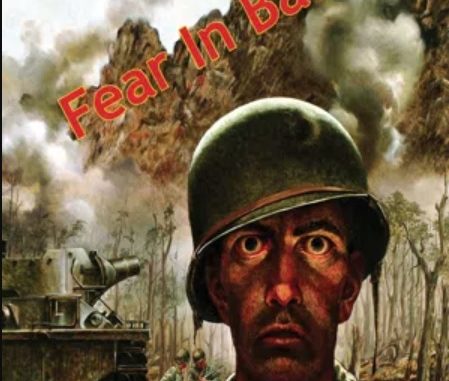
I recently came across a fascinating and little-known wartime publication titled Fear in Battle (1944) by psychologist John Dollard. Issued by the Infantry Journal Press during the Second World War, this report offers a remarkably honest and psychologically insightful look into how soldiers experience and manage fear in combat. Drawing on data from 300 veterans of the Abraham Lincoln Brigade—American volunteers in the Spanish Civil War—Dollard explores fear not as weakness, but as a natural and sometimes even useful part of battle. Given how rarely this document is discussed today, I thought it would be worth sharing an overview of its key ideas. It’s a compelling mix of data, personal testimony and psychological insight, and sheds light on the emotional realities of war from a perspective not often seen in official military literature.
Background and Context
In 1944, during the height of the Second World War, the Infantry Journal Press published “Fear in Battle” by John Dollard, a social psychologist affiliated with Yale University’s Institute of Human Relations. The report emerged from a broader psychological interest in morale, fear and combat performance. It represented one of the earliest rigorous attempts to scientifically understand how soldiers experience and manage fear in wartime.
The research was rooted in fieldwork conducted with veterans of the Abraham Lincoln Brigade (ALB), a group of American volunteers who fought in the Spanish Civil War. Dollard and his team used a 44-page questionnaire, developed after 20 recorded interviews, and administered it to 300 ALB veterans.
While these fighters were not typical American troops – they were volunteers, ideologically motivated and fought with a technically inferior army – their experiences offered profound insights into the human psychological response to combat.
Nature of the Study
The study combines quantitative and qualitative methods: statistical summaries from questionnaires and narrative explanations from open responses. It covers multiple dimensions of fear: its normalcy, its psychological impact, and the personal and organisational strategies soldiers use to manage it.
Dollard doesn’t treat fear as a shameful weakness; instead, he recognises it as an inevitable and sometimes even useful psychological reaction to danger. His work anticipates modern understandings of combat stress and post-traumatic resilience by decades.
What Dollard Says About Fear
Dollard’s central argument is clear and compassionate: fear is normal in battle, and managing it – rather than eliminating it – is the mark of a good soldier.
Here are his key findings and assertions:
- Fear is Universal but Controllable
- 74% of men admitted to being afraid in their first action.
- 85% said they had been “very scared but went ahead anyhow”.
- 61% admitted moments where they “lost their heads”.
Fear, Dollard argues, is not dishonourable; in fact, recognising it and continuing to act effectively defines courage. A soldier should not feel isolated in his fear – it is a shared, human reaction.
- Combat Experience Alters Fear
- 64% reported becoming less afraid over time.
- Combat veterans often learn from repeated exposure: surviving danger once makes it seem less overwhelming the next time.
- However, 14% said fear increased with exposure, likely due to cumulative psychological wear or prior wounds.
Thus, Dollard shows that reactions to fear are not uniform – they are shaped by experience, resilience and trauma.
- Fear Can Be Both Useful and Destructive
- Fear encourages caution and alertness.
- However, 59% noted being “too cautious” at times, reducing effectiveness.
- Distraction and task-focused thinking help mitigate fear. 84% found concentrating on tasks effective, and 96% felt setting a good example helped keep fear at bay.
Dollard promotes distraction as a valuable coping strategy – redirecting mental energy from fear to purposeful action.
- Fear Is Contagious, But So Is Courage
- 70% of soldiers believed visible fear should be suppressed.
- Suppressing fear, Dollard suggests, is not about denial but about protecting morale and preserving cohesion.
Fear spreads quickly in close-knit groups. Discipline, leadership and mutual accountability are essential in preventing breakdowns.
- Motivations Matter
- Identification with a cause – the belief in a just war – was one of the most powerful forces against fear.
- Soldiers who felt they were fighting for something meaningful were more resilient.
- Hatred of the enemy, loyalty to comrades, and pride in their units also acted as bulwarks against fear.
Dollard’s veterans stressed the need for personalised war aims – not abstract patriotism, but concrete reasons to fight. The soldier must feel: “What’s in it for me and my group if we win?”
- Leadership and Morale
- Soldiers value clear orders, informed commanders and frequent communication during danger.
- Good leaders boost morale not just by strategic skill, but by showing care for their men – through food, rest and fairness.
Commanders, according to Dollard, must provide both direction and human connection.
- Fear Is Managed, Not Eliminated
Dollard closes with a psychological blueprint: fear must be recognised, moderated and subordinated to stronger motives – not dismissed or eradicated.
- Courage is not fearlessness, but the ability to act despite fear.
- Training, leadership and equipment are essential, but so too are personal conviction, group loyalty, and emotional connection to the cause.
When fear is too strong, it leads to panic. When too weak, it leads to recklessness. The goal is balance.
Conclusion
John Dollard’s Fear in Battle is a seminal document that redefined military psychology by affirming the humanity of the fighting man. Rather than pathologising fear, he normalised it and highlighted the social and psychological structures that help manage it. His emphasis on cause, leadership, camaraderie and self-awareness remains highly relevant – not only to soldiers, but to anyone facing extreme pressure or danger.
Fear, he teaches us, is not the enemy. It is part of the human condition – and with the right tools, it can be overcome.

